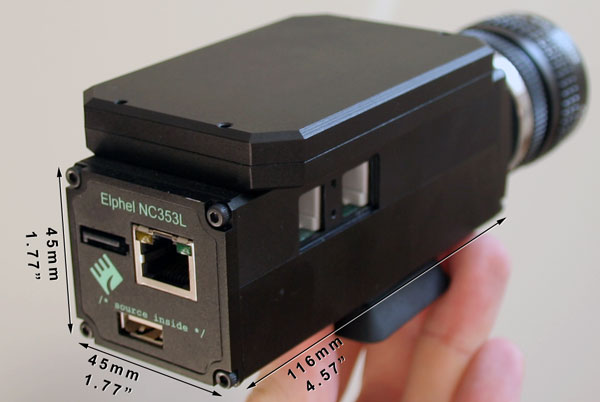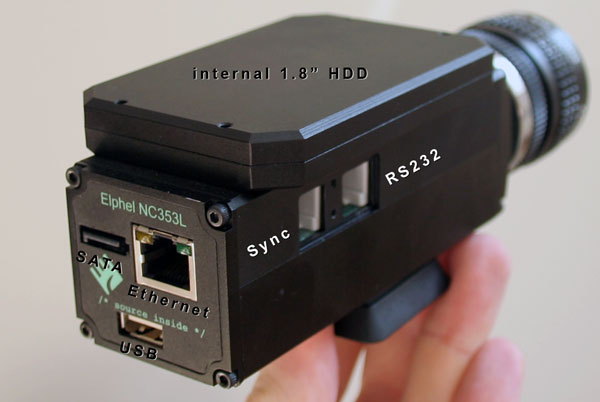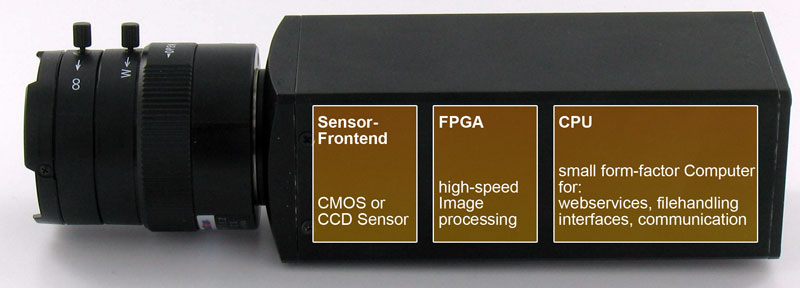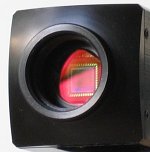353 in a nutshell
This page should give a very brief overview about all aspects of what the Elphel 353 camera is about.
Contents
[hide]Dimensions & Weight
Example: NC353L-10369-HDD with 10369 IO board and internal 1.8" HDD installed:
Dimensions without HDD: 116mm х 45mm х 45mm
NC353L Weight: 150 - 215g (depending on installed internal hardware, excluding HDD)
Connectors
Example: NC353L-10369-HDD with 10369 IO board and internal 1.8" HDD installed:
SATA: Can be used to connect any external SATA device that is supported under Linux
Ethernet: 100MBit Network with 48V DC power provided through spare pairs (4/6 and 7/8)
USB: USB 1.1 with 5V power supply
IDE: Used to connect internal HDD
Sync: Can be used to sync multiple cameras or trigger shooting images externally
RS232: Access to Console and debug output
Internal Hardware Modules
Strongly simplified the camera can be split up in 3 different hardware modules with their specific tasks:
Lens: The camera has a standard C-mount but ships with an adapter ring that allows to mount CS-lenses as well.
Sensor-Frontend: houses the actual sensor that delivers the digital image
- Aptina 5MPix CMOS (video sensor)
- Kodak 11MPix CCD (still image sensor)
- Kodak 16MPix CCD (still image sensor)
FPGA: (Field Programmable Gate Array) processes the incoming image data (color manipulations, compression, etc) in realtime
- Xilinx (R) Spartan3e 1200K gates
CPU: can direct the processed image stream (video) over a network or into a file (HDD or CF card), it can do all tasks a normal embedded computer can do (web server, peripherals, etc. )
- Axis ETRAX FS (200Mhz CPU, 64MB SDRAM, 128MB system flash memory, 64MB image memory)
Sensors
There are 3 different modules that can be used as sensor front-ends:
Aptina 5MPix CMOS:
This cost efficient bayer-pattern sensor has a size of 1/2.5" (5.70mm x 4.28mm) and a resolution of 2592x1944. It allows a maximum frame rate of around 15 fps @ full resolution, 30fps @ Full HD (1920x1080) or 60 fps @ HD (1280x720). It features a 12 bit ADC and supports: region of interest, on-chip binning and decimation.
Optionally you can request a 5Mpix monochrome or 3Mpix sensor upon purchase.
Kodak 11MPix CCD:
This high grade (also high price) full-frame (36mm x 24mm) sensor requires the 10347 controller and 10342 interface board as well as a mechanical shutter. It can supply a maximum of 5 fps. This setup is actually called model 363 not 353 anymore.
Kodak 16MPix CCD:
As above, but requires the 10347 controller and 10344 interface board board and a mechanical shutter. It can supply a maximum of 3 fps. No turnkey solution available.
Power Supply
There are 3 hardware configurations available to provide power to the camera:
- 48V DC power supply using the same cable as used for network connection.
- 12-36V DC for mobile applications with best efficiency at around 15V. This also uses the standard network cable. This works with any type of battery pack that can supply a stable current between 12-36V.
- single 3.3V source
Here are some results on power consumption test made in different configurations with Elphel 353 camera, 5MPix sensor, 10349 board, 1,8" HDD,....
| 2400 milliwatts | just booted |
| 3000 milliwatts | after setting image parameters |
| 3700 milliwatts | streamer on |
| 3300 milliwatts | streamer off |
| 3800 milliwatts | streamer on and somebody playing the stream |
| 5000 milliwatts | with streamer on and HD writing at full speed (dd) |
| 5800 milliwatts | streamer on, HD and USB-flash writing at full speed |
| 3300 milliwatts | back to streamer off |



